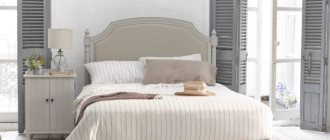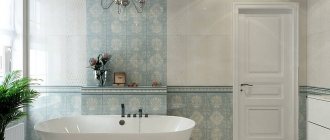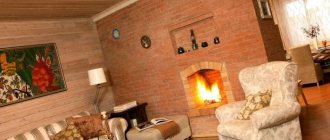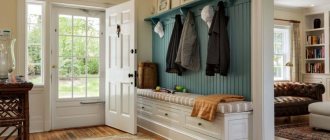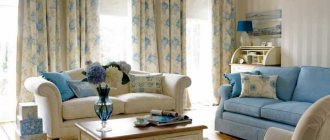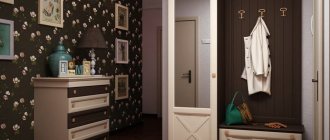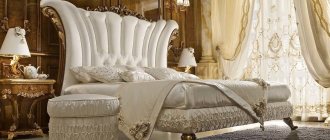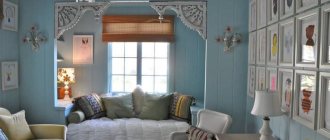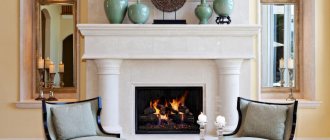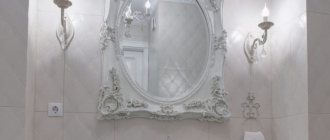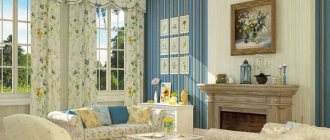Cozy house in Provencal style
A successful decision by the owners is to abandon modern plastic materials in favor of natural ones. The charm of a wooden building made of timber, reminiscent of a village house, is breathtaking and brings back pleasant memories from childhood. The Provence style, which fits so well into the exterior and interior of the building, will help you get one step closer to the dream of a quiet country life in a cozy home.
Features of the facade of a house in Provence style
Provencal house
The design of a country house in the French style should begin from the outside, that is, from the facade of the building. It is its appearance that must meet the requirements of a rustic house in southern Provence. Since French Provence advocates the use of natural materials or their imitators, the main finishing building materials will be: • Natural facade stone; • Natural facing brick; • Wooden beams; • Decorative plaster of a light shade; • Tiles or panels “stone-like”, “brick-like”, “wood-like”.
Stone facade
Sometimes materials atypical for the style are used: for example, siding, simple painting, block house. Strictly speaking, Provence allows you to experiment with the style of the facade, the main condition is that it should be a light, discreet shade.
Siding facade
Most often, several materials are involved in the design of the facade: for example, plaster and stone, wooden beams and facing bricks. By playing with color, size and arrangement of finishing materials, you can create an individual structure worthy of the best French houses.
Living room in French style: 5 color ideas
Living room in Provence style
Although Provence has features that are unique to it, they can be modified. For example, the statement that interior walls and ceilings should only be light in color sounds inappropriate today. The modern abundance of building materials allows you to combine the most unexpected shades, while remaining within the strict boundaries of the chosen style. However, white or its shades must be present in a Provence style room, but not be the only one.
Living room in bright colors
White is the base, and absolutely all colors go with it. The most interesting options for living rooms in the Provence style are rooms with blue, purple, yellow, brown and green colors.
The living room with heavenly inserts is full of freedom, air and space. Being a cool shade, blue will allow you to add other, more cheerful colors to the interior - yellow, pink, green. The number of blue elements in the interior of a light room should not exceed 30%, otherwise the room will receive an unpleasant cold tint, unusual for the warm Provence style. It is successful to experiment with shades of blue: sky, sea, azure and other shades will go perfectly together in a light interior, sometimes without requiring dilution with other colors.
Appropriate use of blue tint in the interior of a white room
Purple or lilac inserts in a bright Provence living room look chic, but the fine line from richness to bad taste is not easy to maintain. The fact is that purple is a flashy, saturated color, which easily turns into vulgar. At the same time, having maintained the edge in design, this color takes on a different sound - appropriate, fashionable and French. To do this, you need to use light shades of purple and in limited quantities: no more than 3 elements in a snow-white room. You can choose two bright objects of the same purple color, and add a third one, different in shade, to them, as was done in the photo:
White Provence style living room with purple accents
A sunny yellow living room pleases the eye and lifts your spirits. Such a cheerful combination will suit the French style perfectly. However, it should be remembered that yellow and white are light shades that do not create the necessary accents. Therefore, it is recommended to dilute this duet with additional colors: for example, orange, red, beige, brown.
Original yellow living room with red and brown accents
Chocolate inserts combine elegantly with the white interior of the living room, adding sophistication and richness to it. Such a room looks strict, majestic and at the same time French. In addition, the duet of brown and white allows you to diversify the living room with other colors to your own taste - red, yellow, lilac. For example, in the photo there is a version of a white and chocolate living room with red accents. This combination is classic and therefore a win-win.
Provence living room with chocolate shades
The green color, pleasant to the eye, goes well with the Provence style, which advocates a return to nature and natural materials. Being the main natural color, green skillfully colors the white walls of the living room and goes well with additional shades - pink, yellow, red. A white living room with green and pink accents will help the owners relax after a hard day at work and find peace of mind.
Green living room with white and pink shades
Bedroom in Provence style: 3 key points
The best bedroom for sleep should be a source of peace and tranquility. For these purposes, the Provence style, soft, warm and romantic, is perfect.
Bedroom in Provencal style
To decorate your bedroom, French Provence has prepared 3 recommendations that will help you get the room of your dreams.
READ ALSO: Cladding a house with stone - some tips and examples with photos
Room decoration
Decorating a country house begins with drawing up a plan and purchasing materials. All repair work is carried out in stages.
The rustic style welcomes an abundance of small decorative elements that make the home feel lived-in and cozy.
See alsoDecor in Provence style
Wall decoration
In rooms decorated in Provence style, the main option for wall treatment is decorative plaster. It is applied in many ways, the surfaces can be uneven and rough. The shades of vertical surfaces should be light. Because of this, the room visually expands, refreshes, there is a feeling of cleanliness, and it becomes possible to install any decor.
Plaster on walls is often specially applied with uneven surfaces
The walls can be finished with wood panels. In such cases, all finishing is done from natural materials. Provence style allows you to paint wall panels white or beige; artificial abrasions look great on them. If the owner wants to create the interior decoration of a village hut, decorative structures can be made, for example, in the kitchen, vertical surfaces can be decorated with tiles or mosaics.
Structural elements are used in the design of walls, for example, logs are not painted, but only treated with protective compounds
See alsoRustic style
Ceiling
In the Provencal style, the ceilings are painted in light shades and whitewashed. In some cases, the surface is decorated with wooden beams; contrasts can be emphasized favorably and the method of artificial aging can be used. If you are decorating a living room or dining room, the ceiling can be decorated with stucco.
As a rule, the ceiling has a light color and contrasting wooden beams
Stucco molding is appropriate on the ceiling in the living room, but it should also look aged
See alsoWe embody Provence style in the interior of an apartment
Floor
The classic of this style is wooden floors. They can be painted or left untreated. All finishing materials must be natural and of high quality. If you are decorating a kitchen or other utility room, you can put tiles on the floor, for example, brown. Designers consider this option practical.
In living rooms, a wooden floor looks most logical. Parquet, laminate or engineered board – it’s up to you
You can lay tiles in the bathroom and kitchen. This solution is practical from a cleaning point of view.
See alsoProvence style in the interior of a city apartment
Windows and doors
In the Provence style, window openings and doors are preferably made of wood. They can be left naturally processed, painted, or artificially aged. To add more natural light to the room, you can make clear glass inserts in the doors. In this style, the “French window” technique is often used. That is, an opening is made from the ceiling to the floor; the window can be used as a door.
The highlight of the style is the “French window” from floor to ceiling, which can be made in the form of glazed door sections
Doors can serve as contrasting elements if made from dark wood
See alsoBedroom design in a modern style
Light filling
Although Provence allows you to experiment with color, the case of the bedroom is special. This is where the line of pastel colors, soft and sleepy, should be maintained. You shouldn’t get carried away with bright colors if you want to get a unique room - otherwise all the charm and all the charm of a Provence style bedroom will disappear in an instant. It is recommended to use white, cream, beige, pale yellow, delicate blue, light green as the main color. Don’t be afraid that the bedroom will look like a hospital: to eliminate this misunderstanding, Provence has prepared 2 more important points.
Bedroom in beige shades of Provence style
Pastel shades
The color palette is very important for this direction. It is dominated by pastel colors. Soft shades of lilac, light blue, mint, peach, pinkish, yellowish will unmistakably set you in the right mood. They are achieved by mixing the main color with white, which is easy to use in practice even for people without experience in color. It’s better to limit yourself to three colors at the dacha in a percentage ratio of 70:20:10, as in classic interior design.
Related article:
Winter crops
Combining them is very simple, since all the bed colors are in perfect harmony with each other. They can be used both inside the house and in the design of the patio.
Romantic flowers
Since there is a light tone at the base of the living room, it can and should be further diluted. Provence suggests using flowers for decoration: real and artificial plants, as well as floral prints and paintings depicting nature. The print can be made as a pattern on walls, curtains, upholstery of an armchair and sofa. Flowers are usually placed near the head of the bed. A good solution would be to use plants in pots mounted on the wall near the bed.
READ ALSO: Always up-to-date classic style in the interior
Using a green shade in the bedroom and Provence decor
Tinted accents
There is a white bedroom, flowers are also present. But this bedroom is still missing something. To complete the beautiful picture, Provence suggests adding one or two color accents to the interior: for example, bright curtains, a rug near the bed, a multi-colored throw on the sofa. With the help of one color element, the bedroom will take on a new meaning and reveal itself to its fullest. The result is an ideal Provence style bedroom, romantic and peaceful.
White bedroom with floral accent wall and bright curtains
Lighting
Each style has certain requirements regarding the selection and placement of lighting fixtures.
Lighting fixtures often use open candle-shaped lamps
Basic rules of Provence style
| Using lamps | They should be made of wood, porcelain. |
| Color selection | Brightness or multiple shades are excluded. It is enough to use 2 colors, the main one is white, the additional one is blue, pink, beige. It is advisable that the entire interior be created using similar shades. |
| Style combination | All lighting fixtures should be combined, even if they are in different rooms. |
Several light sources are installed in the rooms, helping to zone the room and adding accents to certain decorative elements
See alsoEcostyle in the interior: history, photos, tips
Provence style cuisine: 5 steps to France
Where else can a housewife express herself if not in the kitchen? This is where Provence expresses itself fully, allowing you to experiment with color, decor, and materials. Thanks to this style, it is possible to create a real rustic kitchen in a country house. And then the dream of returning to the village, as in childhood, will come true very soon.
Kitchen in blue tones
In the kitchen, Provence pays attention to 5 important details: ceiling, floor, walls, furniture and decor.
Pillows
Another element of this style is decorative pillows. They can be used both on sofas or other upholstered furniture, and for benches or chairs in the gazebo. It is advisable to select them in appropriate colors. A floral theme or cute patterns are suitable, but often just plain lavender shades are chosen.
Related article:
From apples to garden chrysanthemums. Gardening jobs and tips before winter sets in
Ceiling in Provence style
To decorate the ceiling in the kitchen, it is proposed to use wood and materials that imitate them. Wooden beams, wood-effect panels, lining - all this can be used when creating a ceiling design. Preference is given to wood because it is a natural material that fits perfectly with the overall style of southern Provence. It creates the feeling of a country house. However, you shouldn’t focus only on a wooden ceiling: options for a simple whitewashed ceiling or plain light panels are not excluded.
Kitchen in rustic Provence style with wooden ceiling
Features of the kitchen floor
Wood and wooden elements are also often chosen for the floor, mostly in a dark, rich color - it contrasts well with the light kitchen. However, you can use other options: for example, “stone-like” panels and linoleum, “antique” tiles. The main condition is that the floor should not deviate from the overall style. Therefore, the shade is selected according to the existing color inserts in the room. A popular and characteristic move for Provence is grouting the floor or artificially aging it. First, paint is applied to the material, which is then partially erased, achieving an aging or fading effect.
Bright kitchen with slightly worn floor
Provence kitchen walls
Finishing materials for the wall can be varied, and here the Provence style does not limit the choice. The main criteria are the color and naturalness of the material. Finishing stone or brick (artificial and natural), imitation panels (especially “wood-like”), light tiles and simple plaster with a fading effect are suitable. Wall materials should be combined with the ceiling and floor and not deviate from the overall color scheme. For example, stone walls are perfect for a ceiling with wooden beams, and simple plastered walls are perfect for panels on the ceiling and tiles on the floor.
Spectacular wall design using tiles
At the same time, a popular combination is light floors and dark walls and vice versa. The kitchen can also be colored: in this case there should be one accent spot. This could be an apron, a bright kitchen cabinet, curtains, one wall or an entire kitchen unit (then the rest of the space should be a neutral color).
Kitchen with light furniture and red wall
Main features and characteristics of Provence
Buildings in the Provence style look original and proud. There are stone and wooden, rectilinear and refined, simple and half-timbered, with a gable and multi-gable roof. In the historical homeland of the style, they liked to experiment with design, to stand out somehow, then the trend spread throughout Europe, and now people have such diversity.
The essence of the style can be felt in the interior. Whitened pastel colors, soft colors dominate there, and there is a lot of sunlight. Textiles and crafts add harmony. New furniture - neat, openwork and at the same time simple - is accompanied by artificially aged objects and genuine antiques from past times. A full-fledged provincial style is not complete without painting, repeating patterns, and simple colors like polka dots. Elements of luxury came to Provence from classicism and baroque.
The style will be incomplete without fresh flowers: discreet combinations are needed in the area, and diversity is valued in the rooms.
Style color scheme
Natural shades form its basis. There is no place in the style for sharp colors, especially for such transitions. The hallmark of the provincial style is considered to be light, pastel and bleached shades, because in the vast majority of design trends there is a desire for ideal colors. Provence, in fact, “plays” on this contrast. Whiteness is enhanced by abrasion, sometimes by an expressive coating. Metal products with dark corrosion and green patina are also used. Dark colors are left unused or introduced through brown and gray palettes. More often than others, the style contains white, cream, light and dark beige, coffee, yellow, and blue. The second group includes pale tones of light green, pink, and purple. The color of individual rooms consists of 2-3 main shades and secondary inclusions, thus preventing color oversaturation.
Typical finishing materials
They use wood, stone, and terracotta tiles as much as possible, ignoring synthetic raw materials such as laminate and plastic. The walls are decorated with traditional materials:
- wallpaper;
- whitewashing;
- paint;
- plaster;
- clapboard.
It won’t be a problem if the lining is made of imitation wood and the wallpaper is non-woven, but only certain areas can be decorated this way. Oversaturation of the house with synthetics will lead to the fact that anyone will notice unnatural materials, even those who have never tried to distinguish them by eye. Wallpaper with natural motifs and white paint will always be win-win options. Inside the rooms, the artistic roughness of the bark beetle plaster and the few elements of the brickwork look organic.
Unfinished boards are painted white on their own and placed in any configuration. Creative ideas are realized with mosaics made of tiles and colored glass, and surface drawings.
Walls
The finishing of vertical surfaces is not complete without wood - in interior doors, as well as in window frames, if you follow the classic design.
Paint, wallpaper and plaster are used with equal success as the main cladding. After painting, the effects of a faded coating are created on the walls. Sometimes they draw on wallpaper. Thoughtful and chaotic textures are created on plaster.
In the bedroom and nursery, the same materials are used, but less often plaster and more often lining. In toilets and bathrooms, despite all the variety of waterproof materials, the usual tiles are laid. Patterned and painted products are given preference, and ideally, small mosaics are laid out.
The corridor and living room are done in white or cream, sometimes in shades of coffee. They decorate the rooms as expensively as possible. They buy materials that are expensive and of high quality, without artificially deteriorating their condition, and certainly not trying to save money. It’s not a problem if a small amount of gilding “breaks through” into the interior.
Floor
Flooring finishing options:
- Wood: kitchen, living room, bedroom, children's room, hallway.
- Tiles: kitchen, bathrooms, hallway, bedroom.
Owners will not have much choice, because artificial materials will ruin the appearance of the house. Of course, the rules are sometimes ignored and laminate and linoleum are used, but ideally the choice should lie between different levels of quality of natural raw materials. Painted boards are used to make the floor as white as everything else. Brown and gray material will make a great contrast in a bedroom or nursery. A smooth, neat coating is placed inside the house. Wood with roughness and small defects is used to decorate verandas and terraces. Floors are covered with carpets in about half of the cases.
It can be difficult to choose between wood and tiles, as well as their combination. There is no point in tiling the hallway if there is a wooden floor anywhere in the house. Solid wood flooring in all corridors harmoniously transitions into tiled flooring in the kitchen, bathrooms, and bedroom.
Ceiling
In terms of material color, you won’t have to choose for a long time. There is no point in painting the ceiling anything other than white; as a last resort, they are more original and choose a shade of cream. The materials used are plaster, paint, and whitewash.
In the narrow sense, wood is used. Sometimes there are beams on the ceiling, and if there are none, then several strips of false strips will not interfere. The sharp contrast of the beams with the ceiling does not look the best, so they are selected to match or slightly darker.
Texture is added to the ceiling covering. Together with the provincial style, satin looks best, combining a discreet matte structure and a glossy, light-scattering structure.
Only a few make level ceilings. They look strange in a provincial interior. Historical elements such as stucco molding, caissons and large moldings are always left and played with openwork forms of furniture and fabrics.
Furniture selection
The external simplicity of the style does not mean that you need to buy old, sloppy or angular furniture. Connoisseurs of Provence recommend products in pastel colors, made of noble wood, with attractive lines, ideally with carvings. Artificially aged furniture with evenly distributed imperfections is suitable. Fine and shabby items are not purchased for the same room. At least they make an organic transition within a large space. You shouldn’t pass by painted models, which will add picturesqueness and homeliness.
Armchairs for a provincial setting are selected according to color criteria. Light-colored items such as wicker, wood, or forged with paint are suitable.
The size of the furniture is selected according to the situation, but tradition speaks of compact models as more preferable. Designers allow a combination of furniture in the spirit of Provence with modern wall decoration.
Decoration and textiles
The interior is filled with handmade items. Handkerchiefs and napkins decorate shelves and tables. Toy animals and plant fruits dilute the strict atmosphere. Textiles are decorated with lace. Magnets attach to refrigerators. Chairs and sofas are covered with covers and capes. In each room there are at least 1-2 pots with live plants. Compositions of dry twigs and baguettes will not hurt. All this does not mean that the decor needs to be oversaturated with interesting details; there are other styles for this. Provence is primarily a living, low-tech environment.
Textiles of different colors and from different fabrics are welcome. Products made from natural raw materials such as linen or cotton are suitable. Textiles are used on sofas, lamps, beds, tables, shelves, and also as curtains.
Lighting Features
There are 2 requirements for lighting:
- Give as much natural light as possible.
- Make artificial lighting bright or dim depending on the situation.
A provincial-style home is filled with natural light, as well as white and yellow light from fixtures. Uniform distribution of light throughout the room is ensured by the correct combination of lamps. They don’t use anything special; they use simple wall and floor fixtures, chandeliers, and rotating devices. For atmosphere, add light bulbs that imitate candles. The light density is kept at the desired level by reflective surfaces of decor, mirrors, and silver objects. They try to use lighting to enlarge narrow corridors and kitchens - if there is little free space left in them in the layout of the house. In almost all rooms, standard wrought-iron chandeliers are used, in small ones they are limited to simple ones, and in large ones they purchase multi-level ones. External lighting is provided with wall lamps and imitation torches. A simple lamp illumination is hung above the terrace.
Provence style kitchen furniture
An interesting practice is the artificial aging of furniture. An old wooden cabinet is great for this purpose, painted with plain white paint and then scraped off to create the effect of an old piece. To achieve the most believable result, apply paint of a different color to the scuffs, as if showing through under the layer from below.
Shabby kitchen cabinet
Arranging contrasts also works great with furniture: if the kitchen and furniture are white, then you should choose dark furniture.
Light kitchen with dark furniture
The main material of kitchen furniture is wood. It is painted, varnished, cleaned, aged.
Wooden table with rough paint finish
Furniture
Provençal furniture does not lose the spirit of style either. It is old, reliable and almost always made of wood. It should be remembered that peasants are very economical people who do not part with things well and honor traditions. That is, new things in the house can appear only when there is not an aesthetic, but a technical need for it.
And, of course, Provence will not tolerate any laminated surfaces. The facades should be carved and painted to match the whole house. It’s best to use the same paint brush.
In addition, this type of country style is characterized by sideboards and racks with open shelves, on which kitchen utensils are placed like decor.
